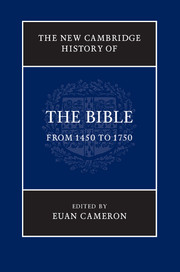Book contents
- Frontmatter
- Contents
- List of figures
- List of contributors
- Preface
- List of abbreviations
- Introduction
- PART I RETRIEVING AND EDITING THE TEXT IN EARLY MODERN EUROPE
- 1 The study of tongues: The Semitic languages and the Bible in the Renaissance
- 2 The revival of Greek studies in the West
- 3 Humanist Bible controversies
- 4 The Old Testament and its ancient versions in manuscript and print in the West, from c. 1480 to c. 1780
- 5 Critical editions of the New Testament, and the development of text-critical methods: From Erasmus to Griesbach (1516–1807)
- 6 In search of the most perfect text: The early modern printed Polyglot Bibles from Alcalá (1510–1520) to Brian Walton (1654–1658)
- PART II PRODUCING AND DISSEMINATING THE BIBLE IN TRANSLATION
- PART III PROCESSING THE BIBLE: COMMENTARY, CATECHESIS, LITURGY
- PART IV THE BIBLE IN THE BROADER CULTURE
- PART V BEYOND EUROPE
- Afterword
- Select bibliography
- Select Bible bibliography
- Index
4 - The Old Testament and its ancient versions in manuscript and print in the West, from c. 1480 to c. 1780
from PART I - RETRIEVING AND EDITING THE TEXT IN EARLY MODERN EUROPE
Published online by Cambridge University Press: 05 August 2016
- Frontmatter
- Contents
- List of figures
- List of contributors
- Preface
- List of abbreviations
- Introduction
- PART I RETRIEVING AND EDITING THE TEXT IN EARLY MODERN EUROPE
- 1 The study of tongues: The Semitic languages and the Bible in the Renaissance
- 2 The revival of Greek studies in the West
- 3 Humanist Bible controversies
- 4 The Old Testament and its ancient versions in manuscript and print in the West, from c. 1480 to c. 1780
- 5 Critical editions of the New Testament, and the development of text-critical methods: From Erasmus to Griesbach (1516–1807)
- 6 In search of the most perfect text: The early modern printed Polyglot Bibles from Alcalá (1510–1520) to Brian Walton (1654–1658)
- PART II PRODUCING AND DISSEMINATING THE BIBLE IN TRANSLATION
- PART III PROCESSING THE BIBLE: COMMENTARY, CATECHESIS, LITURGY
- PART IV THE BIBLE IN THE BROADER CULTURE
- PART V BEYOND EUROPE
- Afterword
- Select bibliography
- Select Bible bibliography
- Index
Summary
In 1753 controversy broke out in Oxford over an essay published by Benjamin Kennicott (1718–83). Kennicott compared the text of 1 Chronicles 11 with that of 2 Samuel 5 and 23, which appeared to be parallel descriptions of the same set of events. In so doing he identified numerous textual discrepancies and inconsistencies, many of which appeared to derive from errors of transcription. These were compounded further when Kennicott made reference to other ancient witnesses to the text. The Greek of the Jewish Bible of the Hellenistic world, the Septuagint, was particularly poorly attested for these passages. All of which made the task of the vernacular translator, whose work Kennicott looked to improve, especially complicated. Although there were Hebraic fundamentalists in mid-eighteenth-century Oxford, including the followers of John Hutchinson who comprised some of Kennicott's bitterest opponents, these were not surprising findings to the world of early modern scholarship. Kennicott built knowingly on the work of the early seventeenth-century Huguenot critic from Saumur, Louis Cappel (1585–1658). Cappel's Critica sacra (Paris, 1650) treated the Hebrew and Greek texts of the Old Testament as parallel witnesses, and discredited the notion, commonly held by Protestants in particular, that the contemporary Hebrew Bible, including the vowel points, represented the original state of the text. Such scepticism looked back to the arguments of the foremost early sixteenth-century intermediary between Hebraic scholarship and Christian readers, Elijah Levita (1469–1549). As such, it was grounded in the scholarship that had produced the very printed texts on which later critics and translators relied – the rabbinic Bible whose third edition (Venice, 1548) Levita helped to edit; the dictionaries of Hebrew and Aramaic that he compiled – as well making use of the conclusions of Levita's studies of the rabbinical critical apparatus (or Masorah, which had codified certain earlier, oral traditions concerning the reading of the biblical text).
Later critics, notably the Oratorian Richard Simon (1638–1712), had admired Levita's work and started to extend it. They examined for themselves manuscripts of the Hebrew Bible and its principal ancient translations, and they reconsidered the authority of existing printed versions.
- Type
- Chapter
- Information
- The New Cambridge History of the Bible , pp. 82 - 109Publisher: Cambridge University PressPrint publication year: 2016
- 4
- Cited by

